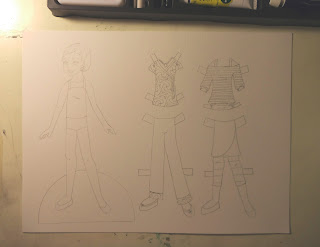I think I mentioned in the last lesson that it's been a very long time since I used acrylics. And it shows! I'm used to painting in watercolors lately, and it took a little time to remember how different acrylics were! I'm not an expert with acrylics -- this is just the method I used. There are much, much better acrylic painters out there!
Also, I had a studio assistant today. My oldest son wanted to watch me paint. It was a bit of a distraction and my painting didn't come out quite the way I wanted, but it's important to me to encourage my kids to love art.
Materials list:
- Heavy paper (I'm using watercolor paper)
- A doll sketched lightly on the paper
- Pencil, eraser
- Acrylic paints
- Palette
- Lots of water & brushes
Here's the sketch I started painting. Conveniently, I had the page from the patterns lesson drawn out but not painted!
These are the palettes I've been working with. The round palette is where I mixed my colors, while the palette on the right is for the straight-from-the-tube color. I've said before that you should mix more paint than you think you'll use, and this is especially true with acrylics. They dry fast (unless you use a slow-drying medium) and once the color is dry, it's gone. Acrylics require some planning.
I found the easiest thing to do was to work with one color to completion. I started with the skintone. If I have one complaint about the Reeves paints I've been using it's this: the burnt sienna has a terrible consistency. It could just be the tube I have, but it's awful. Very thick and very grainy. I mention that because it's a staple in my palette, specifically for creating skin tones.
It's possible to work wet-in-wet with acrylics if you use a slow-drying medium or can work remarkable fast. I chose not to go this route. My shading here is minimal. I used my previous skin tone and darkened it with more burnt sienna. I knew that I wouldn't use that color again, so I just added the color directly to the previous pot of color.
Given the speed with which acrylics dry, I decided that the best method would be to take the color all the way to the end. I further darkened my skintone pot of color and outlined the skin toned areas. Typically, I don't work like this. I block in all of the colors and build from there. With acrylics, it was more important to get the colors exactly the way I wanted, so some sections are more finished than others.
I'm continuing to add colors one at a time here. The reds and blues are essential straight from the tube, so I'm less concerned about taking these sections all the way to outlines.
Continuing to add color. Try to work left to right so that you don't smear your paint! (If you're right handed, of course.)
More color. Shading didn't come out the way I wanted....
The final painting.
A few observations:
- Acrylics are great for painting light over dark
- The next time I use acrylics, I'll try some different mediums. I found shading very difficult. Acrylics can be thinned with water but it's just not as effective as using a specially designed medium.
- Have separate brushes! I was a bit hesitant in my painting because I was trying not to ruin my watercolor brushes.
- Plan ahead! Acrylics dry quickly. Be prepared and work fast.
I would like to experiment with a more oil-like painting experience with oils. I think that's really where they'll shine.
I'll be posting a doll on Friday, but I won't have a lesson for a couple of weeks. July is super busy for me -- my husband is taking a vacation (yay!!) as well as two birthdays & a party (where I'm making the cakes). It'll be fun but hectic.
I'm also going to try to tie up some loose ends. I want to complete the paperdoll yearbook for January through June and get that posted. If anyone has suggestions for lessons starting in August, I'd love to hear them.
Look for the fashion doll post on Friday!











No comments:
Post a Comment
Comments post after approval